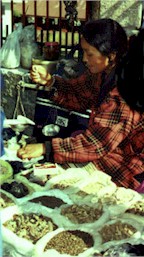Churnas: Ayurvedic Powders
Since Ayurveda recognizes that each individual
is born with a constitutional type that has unique characteristics
as well as requirements in terms of health, it is important to
understand one's type and what are called "doshas." Technically
speaking, dosha means fault; it is not the constitutional
type but rather the problem that arises when the elements contributing
to the dosha are aggravated or "deranged." Given the
right circumstances, almost anyone can, at times, manifest some
of the symptoms of vata derangement
or pitta derangement or kapha derangement,
but if one has such signs of imbalance, it is usually wise to
restore harmony as quickly as possible so as to avoid the complications
of prolonged disturbance.

There is an article on vata
derangement on this site. Vata is caused by excess air
or wind, and the most common symptoms of this derangement are
dryness, restlessness, insomnia, and short-term memory loss.
Much more serious problems can also occur. These include spasms
and a host of conditions affecting the nervous system, aging,
and senility.
The main characteristics of vata
are that it is cold, dry, and light. Coldness can exhibit as poor
circulation or detachment. Dryness affects the viscosity of joints
and moisture in the tissues. It leads to brittleness of nails,
hair, and bones; and is often also associated with constipation.
Lightness is associated with weight loss as well as disorientation
and instability.
The herbs and spices that correct for vata
derangement need to be warm, moist, and heavy. The favored herbs
are ginger for warmth, cinnamon for its mucilaginous properties,
and asafoetida for its grounding effects. Since vata is caused
by deranged air, it is useful to understand the two sides of
air. The aromatic properties of food and herbs not only please
the senses but neutralize toxic wind. These herbs are usually
carminative, tasty, and mildly stimulating. Fennel is a lovely
example of an herb with great affinity for air. It is delicate,
willowy, and subtle. These mildly stimulating herbs are tolerable
to people who feel fragile and they aid assimilation of nutrients.
Stinky herbs, like garlic and asafoetida are grounding. They
are earthy and heavy and help to anchor people who are feeling
blown around by the wind.

I have been remiss in not posting more on pitta
problems. Pitta can be best understood as derangement of the fire
element. This can occur because of exposure to toxins or infection.
It can also result from alcohol abuse or anger. The properties
of pitta are that it is hot, dry, light; i.e., it is similar to
vata except that it is hot rather than cold.
The symptoms of deranged fire are usually acute
and painful. They have a sudden onset and are usually serious when
they affect children and the elderly, but they are seldom as dangerous
for people in their prime who are otherwise healthy. The most typically
pitta symptom is fever, but many people today have been so heavily
vaccinated and loaded with antibiotics that they do not run fevers.
Instead, they exhibit other pitta symptoms such as impatience,
temper, and inappropriate jealousy or competitiveness.
The herbs and spices that are used to pacify pitta
are less pungent than those used for vata derangements. In theory,
if you eat in a Thai or Mexican restaurant and you have a choice
of one, two, or three chilis, the pitta person should go easy on
the cayenne! Also, because fire resides in the digestion system,
such persons may secrete more hydrochloric acid and other gastric
juices. They should therefore favor the alkaloids and go easy on
the acids. Coriander is one of the coolest of the culinary herbs.
Nutmeg is another herb with somewhat heavier properties. Even turmeric,
a member of the ginger family that imparts to curry powders the
yellow color, is quite safe for those with excess fire. Perhaps
more important is the fact that these people fare well on coconut
and coconut milk so the spices can be added to make lovely coconut
curries.

People with a tendency towards kapha derangements
have slow metabolisms and usually some metabolic residuals that
result in congestion and perhaps gradual weight gain. Just as pitta
problems tend to occur suddenly and subside as quickly, kapha conditions
are chronic and often go almost unnoticed for years.
Kapha is cold, wet, and heavy. Unlike vata types,
kapha types do not feel as uncomfortable in the cold. Vata types
really suffer when there is a draft or excess output from a fan
or air conditioner. While those with excess kapha may not really
like the cold, they are not as miserable when exposed to circulating
air or wind. Also, even if their hands and feet are cold because
of slow metabolism and poor circulation, they usually do not complain
too bitterly about the cold. In a way, they are used to the subnormal
temperatures, but this isn't healthy so the diet needs to correct
for the tendency towards weak metabolism. These people need very
stimulating spices, ones that are too strong for vata types and
too hot for pitta persons.
These people can handle the hot curries, red chilis,
cloves, and mustard. They need herbs that stimulate secretion of
gastric juices, that promote assimilation, and that increase peristalsis.

Summary
Ayurveda teaches that black pepper
is dosha balancing, tridoshic is the term sometimes used. This
probably surprises some people, but it is worth pointing out that
few Westerners have ever tasted good spices. Most the spices are
old, irradiated, and lacking the volatile oils that account for
much of their flavor as well as medicinal effectiveness. It is
extremely important to recognize that the studies that suggest
that spices are harmful are done with spices that have almost no
redeeming qualities. Good spices are deliciously fragrant and savory
and often beneficial.
Copyright by Ingrid Naiman 2002






